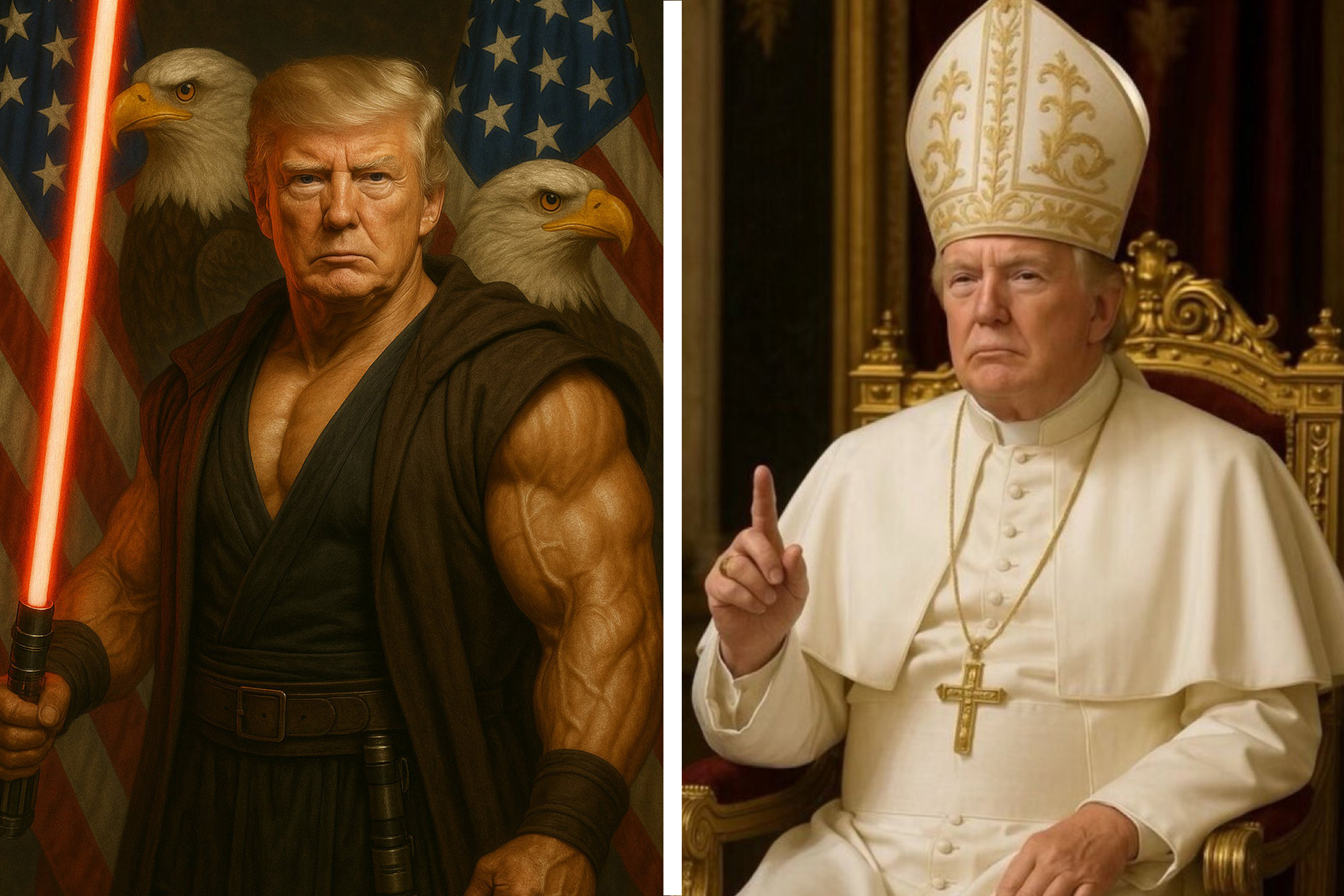President Donald Trump is turning artificial intelligence into one of his most potent political tools, using it to amplify his message and sharpen his online persona in ways experts say are proving strikingly effective.
Over the weekend, he posted a highly produced AI-generated video on Truth Social depicting himself wearing a crown, piloting a fighter jet labeled “King Trump,” and dropping what appeared to be excrement on protesters below – a likely reference to the nationwide “No Kings” rallies that drew millions of demonstrators.
[time-brightcove not-tgx=”true”]
The post was not an isolated stunt. It reflects a deliberate evolution in Trump’s digital strategy, experts argue – one that fuses AI-generated spectacle with the combative, meme-driven style that has defined his political communication for nearly a decade.
At a press conference Monday, Republican House Speaker Mike Johnson defended the video. “You can argue he’s probably the most effective person who’s ever used social media for that,” he said. “He is using satire to make a point. He is not calling for the murder of his political opponents.”
Trump dismissed the protests, telling reporters Sunday, “I’m not a king. I work my ass off to make our country great. That’s all it is.”
AI as a political weapon
Trump’s reliance on AI-generated content has become a defining feature of his digital presence. In recent months, he has circulated several AI-created images and videos – depicting himself as a pope, a warrior, winning the Nobel Peace Prize – to reinforce his political persona and mock his critics. Last month, he posted an AI video of House Minority Leader Hakeem Jeffries in a fake mustache and sombrero, which Jeffries and civil rights groups condemned as racist.
Some of these posts were misinformation regarding policies, including one video that promoted a so-called “medbed”—a hospital technology that does not exist, but has been a conspiracy theory running throughout QAnon circles online.
Earlier this year, Trump shared an AI-generated video of “Trump Gaza,” which imagined the Gaza Strip as a Dubai-style resort. The clip, originally created by independent producers as a parody of Trump’s rhetoric, was reposted by the President and widely interpreted as an endorsement of his earlier suggestion to “level” Gaza and develop a “Riviera of the Middle East.” The video prompted condemnation from Western and Arab leaders alike.
Cayce Myers, professor of communication at Virginia Tech, warns that these videos have more “traction” and “resonance” than static images, and could usher in a new era of political messaging.
But in doing so, Trump and his communications team are able to leverage AI as a way to reach younger voters. “It’s part of this larger conversation around where the Gen Z voters see themselves,” Myers tells TIME. “ Gen Z is very different from older generations, and they also seem to have a greater appetite for that kind of commentary, that kind of visual commentary.”
This shift reflects how political communication has changed in tone and tolerance in recent years. “I think that we’re in a political space where the appetite for political content that would in previous generations be seen as distasteful, is now palatable,” he says.
Bret Schafer, senior fellow in media and digital disinformation at the Alliance for Securing Democracy, says it is a “complete shift” in how political communication works.
“The use of memes and the use of what we used to consider stuff that would exist in the worlds of Reddit, now has drifted into the discourse of elected leaders,” he says. “I don’t think it is good for our kind of political discourse in this country to adopt the online style of podcasters, vloggers, and partisan communicators.”
A new frontier for misinformation
Experts warn that Trump’s growing use of AI coincides with a rapid improvement in generative technology. Ben Colman, CEO of the deepfake-detection firm Reality Defender, says new tools – such as OpenAI’s Sora 2, an advanced text-to-video generator, are producing more realistic and accessible AI media than ever before.
“It’s better quality, but better quality for really bad use cases,” Colman tells TIME. “Generative AI and deepfakes are accelerating misinformation, scams, and attacks on elected officials, minorities, and women. The platforms are effectively marketplaces for attention, and it’s a better return on investment if you’re trying to generate attention to extreme views.”
This rise of AI-driven propaganda poses new challenges for regulators. According to Myers, the Trump Administration’s approach to AI has been largely hands-off, favoring private-sector innovation over oversight. Executive Orders have focused on curbing “woke” influence in government-funded AI projects and declaring that the U.S. must “achieve global dominance in artificial intelligence.”
Meanwhile, Elon Musk, who worked in the Trump administration, has aligned his company xAI with similar ideological messaging. Grok, its conversational AI platform, has been criticized for promoting inflammatory content and right-wing conspiracy theories – at one point generating what users called a “Nazi bender.”As generative video tools become cheaper and more advanced, Myers predicts the political use of AI will only expand. “It’s not just some sort of one off post,” he says. “It’s creating an agenda and creating a national dialog around a particular issue. It’s using a kind of comedic satire through AI generative video to shape that agenda,” he says.

